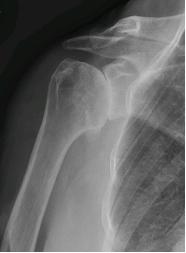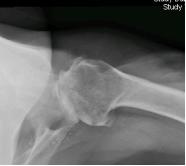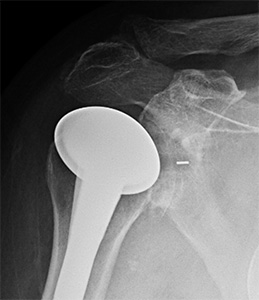Total Shoulder Replacement
Anatomy and function of the shoulder

The shoulder is a ball-and-socket joint between the upper arm bone, which is called the humerus, and the shoulder blade, which is called the scapula. The ball is on the top of the upper arm bone and the socket is on the shoulder blade. However, the socket is not a full cup. It is a shallow depression similar to a golf tee. To prevent the ball from slipping over the edge of the shallow socket and dislocating with heavy lifting, the rotator cuff compresses the ball into the socket. When the ball is compressed into the socket, the shoulder joint is a stable rotational fulcrum for the powerful deltoid and pectoralis muscles. This stable rotational fulcrum allows the arm to lift heavy weights above shoulder and head level. The joint surfaces are coated in a smooth, slippery cartilage surface. This cartilage surface is more than ten times more slippery than wet ice! This surface allows for smooth, frictionless motion of the shoulder.
Shoulder Arthritis


Shoulder osteoarthritis is a “wear and tear” disease in which the cartilage surfaces of the joint are worn away until the humerus bone is rubbing against the scapula bone. Arthritis creates inflammation, swelling, pain, stiffness, weakness, and loss of shoulder function. In an attempted healing response, the bone around the joint creates bone spurs that can also limit motion. Over time, arthritis tends to get worse. Your doctor may recommend anti-inflammatory pills, physical therapy, or steroid injections. While these can make the shoulder feel better, they do not fix the arthritis or prevent it from getting worse. Osteoarthritis is the most common form of arthritis. Other kinds of shoulder arthritis include rheumatoid arthritis (an autoimmune type of arthritis), post-traumatic arthritis (arthritis after an injury to the shoulder), and avascular necrosis (arthritis because of loss of the blood supply to the shoulder).
Total shoulder replacement
In total shoulder replacement, the ball is replaced with a highly polished metal alloy, and the socket is replaced with a very durable plastic. These parts are sized to match your bones. The plastic socket is glued to the shoulder blade with special bone cement. The metal ball is attached to the top part of the upper arm bone as it is coated with a special surface that the upper arm bone will grow in to.
Total shoulder replacement has benefits. The artificial joint removes pain, stiffness, weakness, and inflammation from arthritis. Shoulder replacement surgery is usually a successful surgery, with most patients having little remaining pain and good restoration of their motion and function.
Total shoulder replacement has risks such as infection, damage to the nerves or arteries, medical problems with anesthesia, and many other potential problems. Total shoulder arthroplasty requires that the bone attachment of the front rotator cuff muscle, the “subscapularis”, be cut and repaired at the end of surgery. As a result, patients who undergo this procedure cannot reach behind their back, lift more than 2-3 pounds, or use the arm to push with more than 2-3 pounds of pressure for 3 months after surgery until this repair heals. If these restrictions are violated then the repair will not heal and the replacement will not work. In addition, while shoulder replacements last a long time, they do not last forever. Similar to other mechanical devices, the shoulder replacement lasts longer when it is used more gently.


Click here to download the PDF.
You will need the Adobe Reader to view and print these documents 
